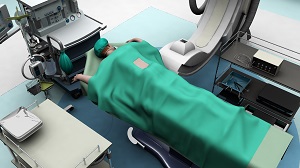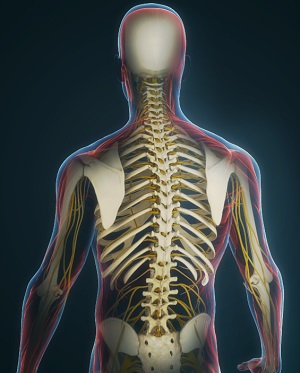General
-
Minimally Invasive Spine Surgery

Minimally invasive spine surgery (MISS) is the latest technology available to perform spinal surgeries through small, less than one-inch-long incisions. It involves the use of special surgical instruments, devices and advanced imaging techniques to visualize and perform the surgery through such small incisions.
Know More -
Spine Deformity Surgery

Spine deformity can be defined as abnormality in the shape, curvature, and flexibility of the spine. When the curves are exaggerated, pronounced problems can occur such as back pain, breathing difficulties and fatigue.
Know More -
Kyphoplasty and Vertebroplasty

Vertebroplasty is a minimally invasive procedure performed under general or local anesthesia. Kyphoplasty is a minimally invasive procedure to relieve pain due to vertebral compression fracture. The procedure is similar to vertebroplasty and is performed under general or local anesthesia.
Know More Launch Movie -
Sacroiliac Joint Minimally Invasive Fusion

Inflammation or irritation of the SI joints may cause pain in the lower back, abdomen, groin, buttocks, or legs. Minimally invasive SI joint fusion is a procedure designed to stabilize the SI joints by grafting the sacrum to the ilium using instrumentation, bone graft, or both in order to fuse the bone, limiting movement.
Know More Launch Movie -
Microdiscectomy

Microdiscectomy, also called microdecompression, is a minimally invasive spinal surgery where your surgeon removes a part of the herniated disc to relieve pressure on the spinal nerves.
Know More Launch Movie -
Revision Spinal Surgery

Revision spine surgery is surgery performed in certain patients to correct the problems of earlier spine surgery.
Know More -
Spinal Decompression

Spinal decompression is a treatment to relieve pressure on one or many “pinched nerves” in the spinal column. It can be achieved either surgically or by non-surgical methods. Spinal decompression is used to treat conditions that cause chronic backaches such as herniated disc, disc bulge, sciatica, and spinal stenosis.
Know More -
Laminectomy

Laminectomy refers to the removal or cutting of the lamina (roof) of the vertebral bones to provide space for the nerves to exit from the spine. It can also be performed to relieve the symptoms of the narrowed spinal canal known as spinal stenosis.
Know More -
Kyphoplasty

Balloon kyphoplasty is a spine surgery that relieves back pain caused by a vertebral compression fracture. The aim of balloon kyphoplasty is to relieve pain, stabilize the fracture and restore the vertebral body height.
Know More Launch Movie -
Spinal Cord Stimulator

A spinal cord stimulator is a device that sends electrical impulses to the areas of the spinal cord causing pain and interferes with the transmission of pain signals to the brain.
Know More Launch Movie -
Outpatient Spine Surgery

Outpatient spine surgery is an operative procedure that does not require an overnight stay at the hospital. It is also called ambulatory or same-day surgery.
Know More -
Removal of Facet Joint Cyst

Facet joint cysts, also called synovial cysts, are benign, fluid-filled sacs that develop due to degeneration of the facet joints of the spine. These cysts normally occur in the lumbar spine (lower back) area and may not cause problems, but when large enough, they can cause spinal stenosis or narrowing of the spinal canal leading to compression of the spinal cord or spinal nerves.
Know More -
Motion Preservation Surgery

Motion preservation surgery or Motion Preservation Spine Surgery (MPSS) is a relatively new surgical method employed as an alternative to standard spinal surgeries, such as spinal fusion surgery and disc replacement surgery in select patients to treat spinal conditions of the cervical and lumbar area and restore normal motion of the spine.
Know More -
Microscopic Spine Surgery

Microscopic spine surgery is a minimally invasive surgical procedure performed using state-of-the-art technology to treat conditions pertaining to the spine.
Know More -
Treatment Options for Back and Neck Pain

Pain in the back and neck are the common symptom of injury, damage, or deformity of the spine. Pain may range from a mild ache to a sharp shooting pain that can spread down your arms and legs. There are many conservative and surgical treatment options that can relieve pain by targeting the symptoms or the underlying problem.
Know More -
XLIF - Extreme Lateral Interbody Fusion

Extreme lateral interbody fusion (XLIF) is a minimally-invasive surgery that involves the fusing of two degenerative spinal vertebrae. The procedure is conducted to relieve painful motion in the back caused by spinal disorders.
Know More -
Disc Arthroplasty

Disc arthroplasty or artificial disc replacement is a spine surgery to replace a degenerated (deteriorated) disc with an artificial disc. The artificial disc is used to replace the degenerated disc to support the vertebrae while still allowing backward and forward bending, side-to-side bending, and turning.
Know More -
Sacroiliac Joint Arthrodesis

Sacroiliac (SI) joint arthrodesis is a surgical procedure employed for the treatment of sacroiliac joint dysfunction and/or inflammation/pain. The procedure involves surgical immobilization of the SI joint by fusion of the sacrum and ilium bones using instrumentation, bone graft, or both.
Know More -
Robotic Spine Surgery

Robotic spine surgery is a procedure where your surgeon is assisted by a robotic system to perform surgery to the spine. Precision is very important when performing spine surgery.
Know More -
METRx Discectomy/Decompression

METRx discectomy/decompression is a minimally invasive surgical procedure performed using the METRx (Minimal Exposure Tubular Retractor) system to treat problems of the spine. The procedure involves using microscopic or endoscopic techniques to access and remove a herniated disc in the spine to relieve pressure on the compressed nerves.
Know More -
Minimally Invasive Discectomy and Decompression

Minimally invasive discectomy and decompression is a surgical procedure to release pressure on the compressed nerve and restore function.
Know More -
Computer-Assisted Spine Surgery

Computer-assisted spine surgery is an instrument tracking technology in which the surgical instruments are viewed with the help of three-dimensional images of the spine.
Know More Launch Movie -
Minimally Invasive Spine Surgery for Spondylolisthesis

Spondylolisthesis is a condition of the spine characterized by the forward displacement of a vertebra over an underlying vertebra. A significant displacement can cause a compression of the spinal nerves resulting in pain.
Know More
Cervical
-
Posterior Cervical Microforaminotomy/Discectomy

Posterior cervical microforaminotomy/discectomy is an operative procedure that relieves pressure or compression on the nerve roots at the cervical spine.
Know More -
Cervical Arthroplasty

Arthroplasty is a surgical procedure to restore joint function by replacing a damaged joint with an artificial joint called a prosthesis. Cervical arthroplasty is performed to replace the joints in the neck region of the spine.
Know More -
Posterior Cervical Foraminotomy

Posterior cervical foraminotomy is a surgical procedure performed through the back of the neck to relieve symptoms of a pinched or compressed spinal nerve by enlarging the neural foramen, an opening for the nerve roots to exit the spine and travel through the body, and creating more space for the spinal nerve to pass through.
Know More -
Cervical Laminoplasty

A cervical laminoplasty is an operative procedure that involves reshaping/repositioning the bone at the neck region (cervical spine) to relieve excess pressure on the spinal nerves. It can also be performed to relieve the symptoms of the narrowed spinal canal known as spinal stenosis.
Know More -
Cervical Foraminotomy

Cervical foraminotomy is a surgical procedure performed to relieve the symptoms of a pinched or compressed spinal nerve by enlarging the neural foramen, an opening for the nerve roots to exit the spine and travel through the body.
Know More -
Cervical Disc Replacement

Cervical disc replacement surgery is an alternative to the traditional cervical spine fusion surgery, which involves the permanent fusion of two vertebral bodies, eliminating movement between them.
Know More Launch Movie -
Cervical Laminectomy and Fusion

Cervical laminectomy is a surgical procedure in which the spinal canal is made larger by removing the spinous process and the lamina in the cervical region of the spine. This reduces neck pain and relieves the pressure on the spinal cord caused by the degenerative changes in the intervertebral discs in the cervical region.
Know More -
Posterior Cervical Fusion

Posterior cervical fusion (PCF), a surgical procedure performed through the back of the neck, involves joining or fusing two or more damaged cervical vertebrae. The fusion of vertebrae is also known as arthrodesis.
Know More -
Posterior Cervical Laminectomy and Fusion

Posterior cervical laminectomy and fusion is a surgical procedure performed through the back of the neck to relieve pressure over compressed nerves in the cervical spine region caused by inflamed spinal tissue or nerves.
Know More Launch Movie -
Anterior Cervical Discectomy with Fusion

Anterior cervical discectomy with fusion is an operative procedure to relieve compression or pressure on nerve roots and/or the spinal cord due to a herniated disc or bone spur in the neck. The vertebra is approached from the from (anterior) of your neck.
Know More Launch Movie
Lumbar
-
Lumbar Foraminotomy

A lumbar foraminotomy is a surgical procedure that decompresses the spinal nerves by removing bone and other tissues that obstruct the neural foramen.
Know More -
Lumbar Artificial Disc Replacement

Lumbar artificial disc replacement is a surgical procedure employed to remove and replace a damaged or worn out disc in the lumbar or lower part of your spine that has become painful and debilitating with an artificial or synthetic disc.
Know More -
Lumbar Laminectomy

Lumbar laminectomy is a spinal surgery to relieve excess pressure on the spinal cord or nerves within the spinal canal in the lumbar or lower back region.
Know More Launch Movie -
Lumbar Decompression

Lumbar decompression is a surgical procedure performed to relieve pressure over the compressed nerves in the lower spine (lumbar region).
Know More -
Lateral Lumbar Interbody Fusion

Lateral lumbar interbody fusion also known as extreme lateral (XLIF) or direct lateral interbody fusion (DLIF) is a minimally invasive spinal procedure performed to treat back and leg pain caused by degenerative discs and other problems within the vertebral column.
Know More Launch Movie -
Lumbar Facetectomy and Foraminotomy

Facetectomy and foraminotomy are the most common spinal surgical procedures recommended for chronic pain due to spinal nerve compression. Lumbar foraminotomy is a decompression surgery involving the removal of bone and tissue obstructing the neuroforamen to release the pressure on the spinal nerve roots.
Know More -
Transforaminal Lumbar Interbody Fusion (TLIF)

Transforaminal lumbar interbody fusion (TLIF) is a type of spinal fusion procedure in which bone graft is placed between the affected vertebrae in the lower back (lumbar) region through an incision on the patient’s back.
Know More -
How to Prevent Back Pain

Back pain is common and usually affects everyone at some point. It often occurs more frequently as you grow older. Pain can either be sharp and sudden or dull and constant. Acute back pain lasts a few days or weeks while pain that lasts more than 6 months is considered chronic. Adopting a few good habits and taking certain precautions can help prevent back pain.
Know More -
Anterior Lumbar Interbody Fusion

Anterior lumbar interbody fusion (ALIF) is a surgery performed to correct spinal problems in the lower back. The surgery can be implemented either as an open surgery or minimally invasive technique.
Know More Launch Movie -
Minimally Invasive Lumbar Discectomy

Lumbar discectomy is a spinal surgery that involves the removal of the damaged intervertebral disc(s) to relieve pressure on the spinal nerves (decompression) in the lumbar (lower back) region, which forms the lower portion of the spine and comprises of five vertebrae (L1-L5). A minimally invasive technique is implemented to perform the surgery.
Know More -
Minimally Invasive Lumbar Surgery

Spinal surgery can be performed by two different approaches; one is the conventional open surgical approach and the other is the advanced minimally invasive approach. Each approach has its own advantages and preferences. However, the minimally invasive technique is a more advanced approach with a higher success rate and a minimal level of patient discomfort.
Know More -
Lumbar Microdiscectomy

Microdiscectomy is a surgical procedure employed to relieve the pressure over the spinal cord and/or nerve roots, caused by a ruptured (herniated) intervertebral disc.
Know More -
Minimally Invasive Lumbar Decompression

Minimally invasive lumbar decompression or mild® is a procedure developed by Vertos Medical to treat lumbar spinal stenosis by relieving pressure on the spinal nerves.
Know More -
Minimally Invasive Lumbar Fusion

A minimally invasive lumbar fusion technique is used to treat fractured vertebra, lumbar instability, spine deformities – scoliosis or kyphosis, cervical disc hernias, tumors, back pain, and failed back syndrome.
Know More
Non-Surgical Spine Treatments
-
Epidural Steroid Injections

Epidural steroid injection (ESI) is a minimally invasive approach to treat inflammation of spinal nerves that causes pain in the neck, arms, back and legs. This technique may help relieve back pain in conditions such as spinal stenosis, spondylolysis or herniated discs.
Know More Launch Movie -
Non-Surgical Treatments

In most cases, back pain can be resolved without surgery. The conservative treatment involves the use of pain medications and other methods to reduce inflammation and restore normal function. Usually, some self-care methods and medications can help to overcome back pain, but if pain and inflammation persist over 72 hours, it is necessary to consult your physician.
Know More -
Non-Surgical Treatment for Disc Disease

Non-surgical treatments focus on controlling pain and inflammation and improving function. It can help you get through painful flare-ups and keep you active, which is necessary for recovery.
Know More -
Facet Injections

A minimally invasive treatment called facet injection offers symptomatic relief from back pain caused by inflammation of the facet joints; however, this is not a permanent solution for the condition.
Know More Launch Movie




















































